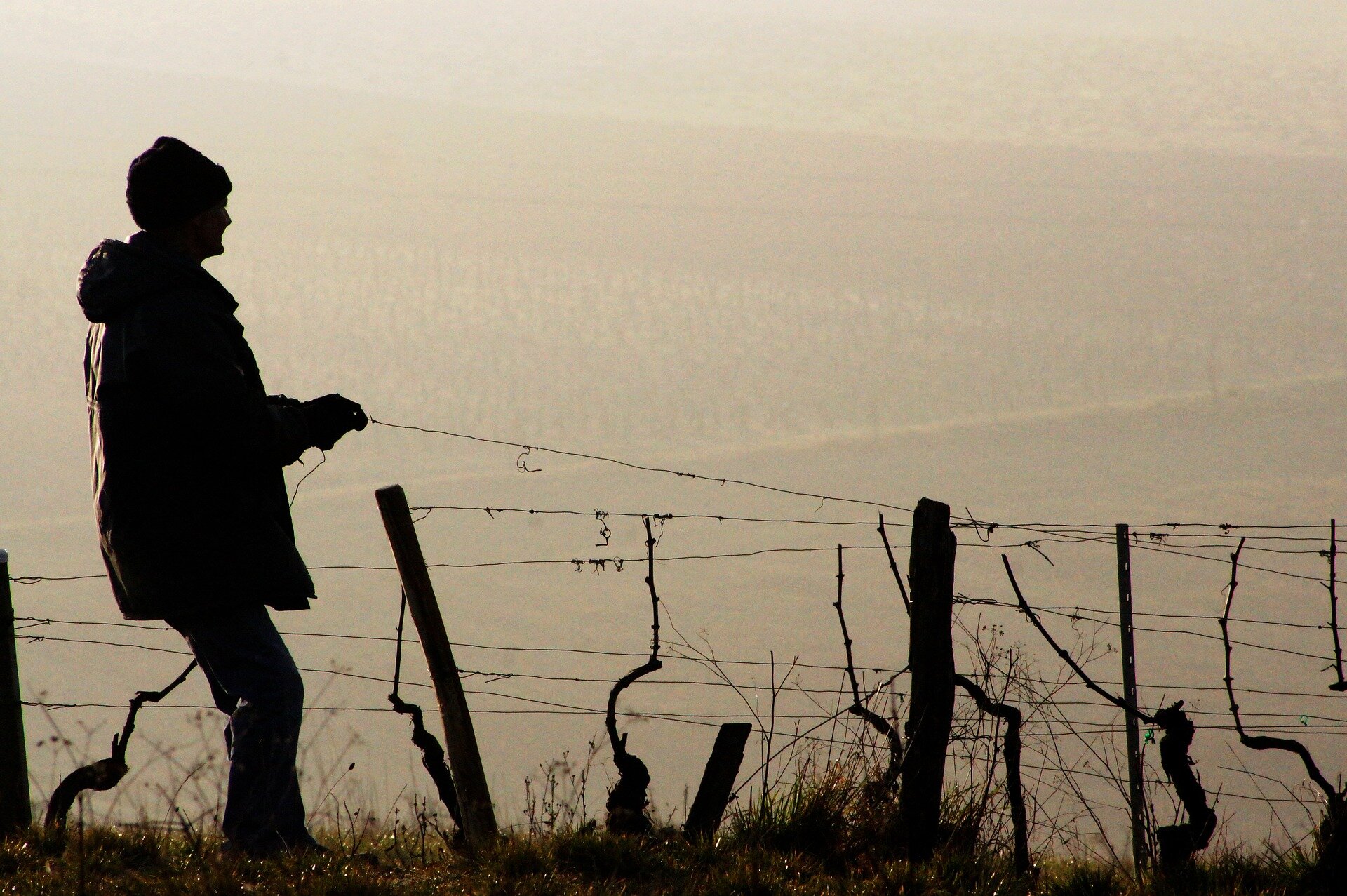
With the winegrower through the year
Our winemakers
Pruning
Statistically, each vine is visited and worked on by the vintner 17 times a year. This means that the wine year also begins as early as January. Equipped with warm clothing, gloves and pruning shears, the vintner prunes each individual vine to ten to twelve eyes per vine. The old canes are removed so that only the new fruiting wood remains on the cane. This work already lays the foundation for the quality of the grapes.
Humus formation in the vineyard
The cut canes are pulled out of the wires, placed in the tramline and crushed there by machine. The nutrients they contain are used to naturally fertilise the soil and thus the vines, with additional nutrient-rich seeding.
Tilting
After cutting, the canes are individually bent horizontally around the wire by hand. This is what vintners call "tilting". As soon as it is a little warmer, the first buds form, which then grow vertically upwards over the summer, forming a beautiful wall of foliage.
Vine blossom and foliage work
The so-called foliage work is the main work period in the winegrowing year and lasts from spring until shortly before the grape harvest. The shoots sprout at different rates depending on the weather. However, the grapes need a ventilated foliage wall for healthy growth. Therefore, excess shoots must be removed right at the beginning so that there is enough air and light. Later, the vintner drives through the rows of vines with a tractor and leaf trimmer and shortens the shoots mechanically.
Until the Ice Saints, many winegrowers leave two canes per vine to minimise the risk of frost. After that, many winegrowers reduce the number of shoots to one. This directs the vigour of the vine into the one remaining vine and increases the quality of the grape juice. By removing a few bunches in the summer, the winemaker can also increase the quality of the wine.
Plant protection is also essential during this period. The national plant protection law must be observed. All plant protection measures are intended to ensure high quality with sufficient yields, but also to protect the environment.
Powdery mildew and downy mildew (fungi) are the main diseases that are naturally present due to humidity and warmth and must be controlled accordingly. But pests such as phylloxera, grape berry moth and the fungus botrytis should not be underestimated and keep the winegrower on his toes. The region's viticultural advisor is an important partner for the winegrowers during this time. He uses forecasting models to determine the treatment period and recommends suitable sprays and their dosages.
Grape harvest
Autumn in the Kaiserstuhl: How exactly is wine actually made from the Kaiserstühl grapes? If you've always wanted to be there live, you now have the chance to look over the vintner's shoulder and "join in the harvest" yourself. The best thing to do is to contact anKaiserstühl winery directly.
The work in the wine cellar
In autumn, the grapes were harvested, either by hand or with a harvester, then separated from the stalks in a destemmer and lightly crushed. With the help of a pump, the mash, i.e. the berries with the juice, was transported into the press. There are different pressing methods: For white wine, the mash is pressed out for up to three hours. The juice is then pumped into a tank, yeast is added and fermented. With white wine, it is called juice from this point on. In some cases, spontaneous fermentation is also carried out without the addition of yeast. In the case of red wine, the mash is pressed after about 14 days of fermentation (with or without yeast). The red wine gets its colour from the berry skins in the mash. This is called mash fermentation. Another red wine process is mash heating, in which the mash is heated to over 80 degrees. Fermentation means that the sugar is converted into alcohol.
After about two weeks, the new wine is separated from the yeast. The new wine matures until Christmas or longer in the barrels - in wooden barrels or steel tanks.
The cellar master checks the ripening process of the young wine weekly and decides, depending on the quality, which wine line in the assortment the wine will be assigned to. During the turn of the year, the laboratory tests take place. In spring, the wine is then filtered, bottled, labelled and packaged.
Did you know that ...
... for the ice wine harvest - usually in December - the grapes must have minus seven degrees on the press? If this is not achieved, the grapes can be processed into the quality levels Beerenauslese or Trockenbeerenauslese, depending on their sugar content.
Wine Knowledge Kaiserstuhl & Tuniberg